Sequence viewing > Index - Alternative Photo Emulsions - Resource - ©
Lloyd Godman
Alternative
Photographic Processes - (Hand
made photographic -emulsions and processes)
Papers
& other support bases for alternative photographic processes:
While a variety of surfaces can be coated with various emulsions, paper
is the most widely used for most processes and the most preferred. There
is a great range in the quality, strength, weight, surface texture and
even colour of different papers.
Objectives
Before
you begin experimenting ask what out come you would like to have with
the final prints. If you are looking to produce fine art prints of archival
standard - the highest quality that remain stable, then you will need
to use high quality paper that is expensive. If on the other hand you
are more interested in the aesthetic qualities, you might want to work
with old paper which carries stains and artifacts from a past life.
However, don't expect these papers to remain stable over a long period
of time.
Papers:
What
ever paper you decide to use, you need a paper that is strong enough
to process, and one which is either presized or you coat with a size
to prevent staining of the paper.
The
best papers for this procedure will be those that are not too soft and
have been sized.
Working
with paper and processes that do not require highly sized paper makes
working much easier.
Unsized
papers will soak the sensitizing solution too deeply and unevenly into
the paper. (If you wish to experiment with softer papers, you may need
to size them with gelatin before coating them.) Use any paper that can
stand soaking, such as many watercolor, etching, and charcoal papers,
commercial offset cover stock, or heavier sketchbook pages. Clobbered
papers may bleed or fade. Any paper can be coated with an emulsion but
there is great variation in both the and physical strength of papers,
and many are not suitable for coating.
Recommended
papers that need no size:
Arches
Arjomari - This is a french made paper - 100% cotton-
mould made - Gelatine tub-sized - air dried - 4 Deckle edges wter
marked - Grain Sartine hot pressed - 300 G/m2 56 x 76 cm |
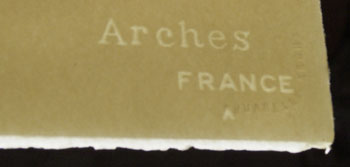
Water mark
in Arches Arjomari paper
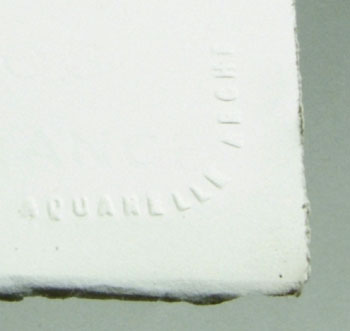
Raise
embossed aquarelle Arches marking in the corner of the paper.
|
Arches
BKF Rives - 560 x 760 Velin Arches Blanc - This paper
may require sizing |
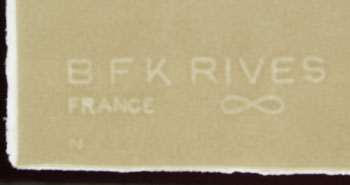
Water
mark in Arches BKF Rives paper |
| Fabriano Satine Water Color Paper 300 grms |
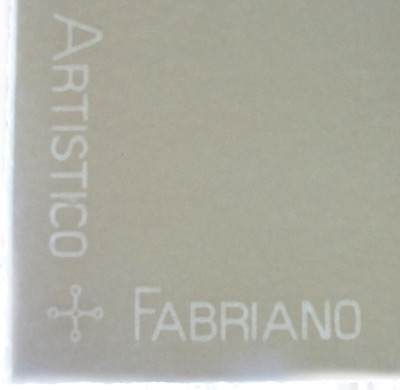 |
| |
|
Ingres d'Arches
MBM
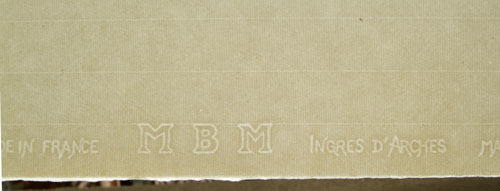
MBM
ingres d'Arches
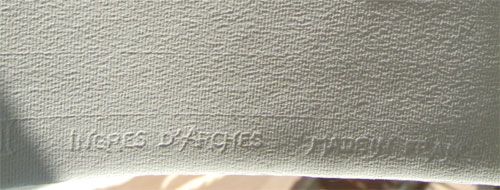
Arches - water colour paper 185 GSM 100% cotton - French
made
Arttec Oil sketchpad paper - Australian made
Canson drawing paper 220 gram
acid free - For the Arcane
project Tess Edwards and my self used this paper
Canson Montval - This is a French made paper which
is 300g/m and has a good surface texture, it is acid free, has no optical
brighteners and is mildew resistant - I used this paper for the LEAF
print from the Impressions
de Lumière project. It is well sized
so it easily washes clean to a bright white of any stains from the cyanotype
process.
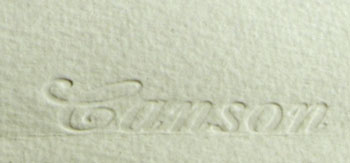
Embossing mark impressed into the Canson Montval paper.
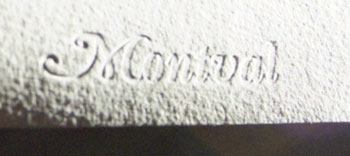
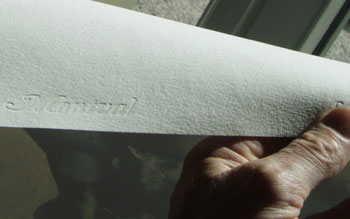
Surface texture of Canson Montval
Crane's
Kid Finish
Hahnemuhle
Fine Art - This paper is used for pigment printing and has
a special coating that makes it difficult to wash out with Cyanotype.
It produces excellent pigment prints for use with some processes over
the top of the pigment like Van Dyke .
HAHNEMÜHLE
'TIEPOLO' paper (450gsm/200lb) (A FINE PAPER MANUFACTURER FROM GERMANY, with origins
in the 16th century.)
A 100% cotton paper, fully sized, acid free, needs no stretching, available
either Matt (NOT) or Rough surface:
Lana
Royal
Magnani (Cartiera)
Water mark on Mangnani paper |
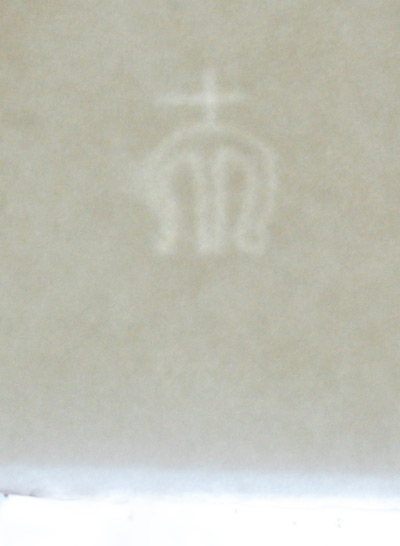 |
Strathmore
watercolor paper - hot pressed
Paper
strength & weight:
It
should be remembered that any paper or support base is not only coated
with the liquid emulsion but processed in liquid and needs to be strong
enough to withstand this processing and washing. I have seen artists
coat a thin piece of tissue paper with emulsion and then watch as it
disintegrated during the processing. If you are unsure about a paper,
test a small paper sample by soaking it in water at least an hour, or
overnight, then pick it up and turn it over several times. If it tears
easily or falls apart, it is unsuitable. Although the quality of paper
differs greatly, the thickness of the paper gives some indication of
strength. I have found 220gm weight paper very effective, but this relates
to the strength of the paper and the physical dimensions of the sheets
you are working with.
The
larger the sheet dimensions, the greater the weight needs to be.
Using
soft papers
Often
it is not the construction of the paper but the weight and handling
when wet that destroys it. A method where finer and softer papers can
be taped down onto a board to coat expose and process it can be useful
in retaining the sheet intact. (Use wettable package tape for this).
If you don't want to introduce acid or contaminate the paper the board
should be coated with sanding sealer or polyurethane varnish. Remember
that if the paper is taped down this edge will be lost when the print
is cut off the board.
pH
value of paper:
The
pH value of the paper and other additives in any paper determines stability
of the paper over time. Papers with a low acidity will last a much longer
time than papers with a high acidity. The purest papers are referred
to as having a pH of 7 which is designated as neutral and the same as
water. Using papers or materials with a higher acidity means they will
react over time. Paper surface: Papers come in a range of surfaces which
can be incorporated as part of the aesthetics or concept of the work,
and generally course textured papers diffuse the detail of the image
while smooth surfaced papers give the maximum sharpness and increase
contrast.
Paper
surface:
Papers
come in a range of surfaces which can be incorporated as part of the
aesthetics or concept of the work, and generally course textured papers
diffuse the detail of the image while smooth surfaced papers give the
maximum sharpness and increase contrast.
Paper
resources:
While
high quality papers like intaglio or etching paper have the desired
quality, experimenting with a range of papers can produce some interesting
results where the paper augments the image. Good information on paper
qualities can be found at:
http://www.artpaper.com/biglist.html
Storage:
It
is wise to store any work on paper with care. Dust and dirt that collects
on paper left out for a length of time, this in turn collects moisture
and can transfer acid onto the paper. Keep unframed finished works,
or uncoated and processed paper wrapped in acid free tissue paper and
stored in a suitable plastic bag.
The following table shows the width and height of all ISO A and B paper formats, as well as the ISO C envelope formats. The dimensions are in millimeters:
| A Series Formats |
B Series Formats |
C Series Formats |
| 4A0 |
1682 × 2378 |
– |
– |
– |
– |
| 2A0 |
1189 × 1682 |
– |
– |
– |
– |
| A0 |
841 × 1189 |
B0 |
1000 × 1414 |
C0 |
917 × 1297 |
| A1 |
594 × 841 |
B1 |
707 × 1000 |
C1 |
648 × 917 |
| A2 |
420 × 594 |
B2 |
500 × 707 |
C2 |
458 × 648 |
| A3 |
297 × 420 |
B3 |
353 × 500 |
C3 |
324 × 458 |
| A4 |
210 × 297 |
B4 |
250 × 353 |
C4 |
229 × 324 |
| A5 |
148 × 210 |
B5 |
176 × 250 |
C5 |
162 × 229 |
| A6 |
105 × 148 |
B6 |
125 × 176 |
C6 |
114 × 162 |
| A7 |
74 × 105 |
B7 |
88 × 125 |
C7 |
81 × 114 |
| A8 |
52 × 74 |
B8 |
62 × 88 |
C8 |
57 × 81 |
| A9 |
37 × 52 |
B9 |
44 × 62 |
C9 |
40 × 57 |
| A10 |
26 × 37 |
B10 |
31 × 44 |
C10 |
28 × 40 |
Want to learn more? - do a workshop or one on one with Lloyd Godman
|